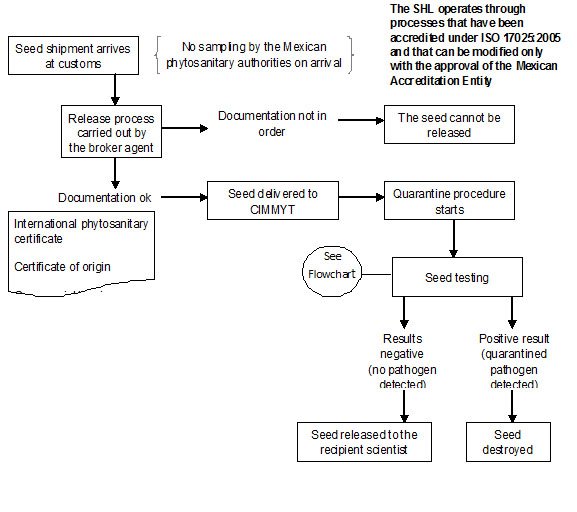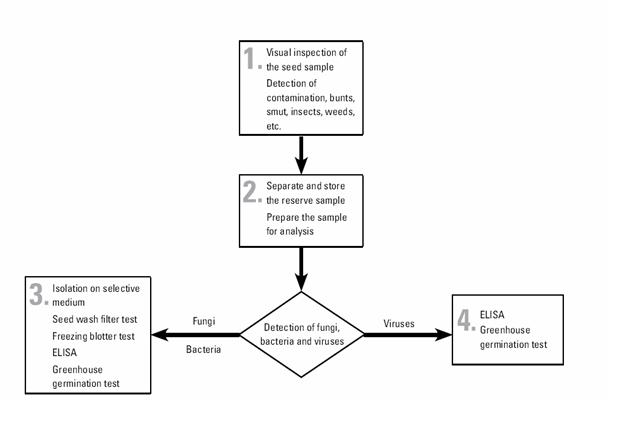Best practices for the safe transfer of maize germplasm
Contributors to this page: CIMMYT, Mexico (Etienne Duveiller, Monica Mezzalama, Eloise Phipps, Thomas Payne, Jesper Norgaard), Independent consultant (Jesse Dubin).
In CIMMYT Mexico, ‘Rules and Regulations for the Safe Movement of wheat and maize germplasm’ have been described by Dr. M. Mezzalama, Head of Seed Health Laboratory (SHL).
Since 1988 the CIMMYT SHL has been officially authorized by DGSV (Direccion General de Sanidad Vegetal) to carry out the quarantine procedures on seed introductions coming into Mexico and CIMMYT, and in April 2007 the SHL obtained accreditation under standard ISO/IEC 17025: 2005, “General requirements for testing and calibration laboratories”, as required by the Mexican government. An official DGSV inspector is assigned exclusively to CIMMYT to assist with thorough and timely seed inspection and importation.
All seed brought into CIMMYT, without exception, must be subjected to quarantine procedures in the Seed Health Laboratory.
The seed introduction procedure at CIMMYT Headquarters is summarized health flow chart

The pathogen detection and identification flowchart is described below:

All maize seed, both entering and leaving CIMMYT, must pass through the seed health laboratory. All seed undergoes the same set of testing procedures, although the key target pathogens vary between incoming and outgoing seed depending on relevant quarantine regulations.
CIMMYT generally uses well-established test procedures that may be found in any standard reference on seed health. The filter wash test is somewhat specialized, and the procedure are given in CIMMYT Seed Health Manual.
The tests used in CIMMYT are as follows:
- physical inspection for smut sori, nematode galls, ergot sclerotia, weed seeds, insect damage, etc.
- Seed wash filter test, which reveals the presence of fungal spores—including bunt teliospores (Tilletia spp.), smut spores (Urocystis and Ustilago spp.), and downy mildew oospores (Peronosclerospora and Sclerophthora spp.)—and of nematode cysts. This test takes around three hours, although large volumes of samples make take longer. Composite samples of outgoing seed may be used (with rechecking of individual lines in the event of a positive result).
- Freezing blotter test, which reveals the presence of imperfect fungi carried by seed and takes two weeks.
- Greenhouse germination test, for the expression, and thus detection, of seed-borne pathogens, and to check seed viability. This test takes three weeks. If symptoms appear on seedlings, further testing to identify the causal pathogen is carried out (i.e. ELISA or other tests).
- ELISA, or enzyme-linked immunosorbent assay, to detect specific bacteria and viruses. This test takes 24 hours.
- Downy mildew detection test. This test, with microscopic examination, detects Peronosclerospora and Sclerophthora spp on maize. It takes 24 hours.
Seed health testing on maize
|
Test
|
Pathogen type(s) detected
|
Pathogens of importance in incoming seed
|
Pathogens of quarantine importance in outgoing seed **
|
|
Seed wash filter test |
Fungi ( smuts) Nematodes |
Heterodera zeae* |
Ustilago maydis
|
|
Freezing blotter test
|
Imperfect fungi
|
Acremonium maydis*
|
Cochliobolus spp. Dilpodia spp. Fusarium spp. Lasiodiplodia theobromae |
|
Greenhouse germination test |
Bacteria
Viruses
|
Burkholderia andropogonis* Clavibacter michiganensis subsp. nebraskensis* Pantoea stewartii* Wheat streak mosaic virus*
|
Acidovorax aveanae subsp.avenae C. michiganensis subsp. nebraskensis P. stewartii Maize dwarf mosaic virus Maize chlorotic dwarf virus Sugarcane mosaic virus |
|
ELISA |
Bacteria
Viruses
|
Pantoea stewartii*
Wheat streak mosaic virus*
|
P. stewartii
Maize dwarf mosaic virus Maize chlorotic dwarf virus Sugarcane mosaic virus |
|
Downy mildew detection test |
|
Peronosclerospora maydis* P. philippinensis* P. sacchari* P. sorghi Sclerophthora rayssiae var. zeae* |
P. sorghi
|
* Quarantined under Norma Oficial Mexicana NOM-018-FITO-1995.
** According to information reported on importing countries requirements
References and further reading
Mezzalama M. 2012. Seed Health: Fostering the Safe Distribution of Maize and Wheat Seed: General guidelines. Third edition. Mexico, D.F.: CIMMYT. Available here (0,5 MB)
Warham EJ, Butler LD, Sutton BC. 1996. Seed Testing of Maize and Wheat: A Laboratory Guide. Mexico, D.F.: CIMMYT. 84 pp
Comments
- No comments found





Leave your comments
Post comment as a guest